新概念英语第一册重点句型
新概念英语第一册重点句型总结
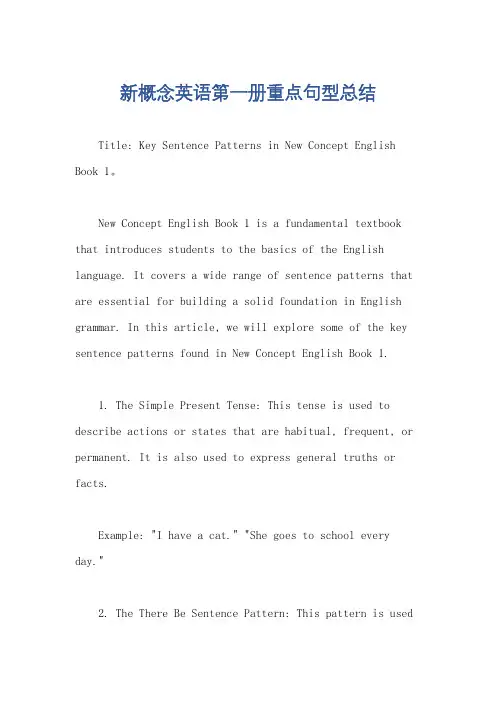
新概念英语第一册重点句型总结Title: Key Sentence Patterns in New Concept English Book 1。
New Concept English Book 1 is a fundamental textbook that introduces students to the basics of the English language. It covers a wide range of sentence patterns that are essential for building a solid foundation in English grammar. In this article, we will explore some of the key sentence patterns found in New Concept English Book 1.1. The Simple Present Tense: This tense is used to describe actions or states that are habitual, frequent, or permanent. It is also used to express general truths or facts.Example: "I have a cat." "She goes to school every day."2. The There Be Sentence Pattern: This pattern is usedto express the existence of something or someone in a particular place.Example: "There is a book on the table." "There are two cats in the garden."3. The Simple Past Tense: This tense is used to describe actions or events that have already happened in the past.Example: "I went to the park yesterday." "She bought a new dress last week."4. The Simple Future Tense: This tense is used to express actions or events that will happen in the future.Example: "I will go to the doctor tomorrow." "They will meet at the station at 10 a.m."5. The Present Continuous Tense: This tense is used to describe actions that are happening now or are in progress.Example: "I am studying now." "She is cooking dinner."6. The Basic Question Formation: Questions in English are formed by inverting the subject and verb. This pattern is used for yes/no questions and wh-questions.Example: "Are you a student?" "What is your name?"7. Imperative Sentences: These sentences are used to give commands or make requests. They are formed by using the base form of the verb.Example: "Close the door, please." "Don't forget to bring your book."8. The Basic Affirmative and Negative Sentences: Affirmative sentences express a positive statement, while negative sentences express a denial or opposition.Example: "I like coffee." (Affirmative) "I don't like coffee." (Negative)。
新概念第一册重点及重要句型1-12
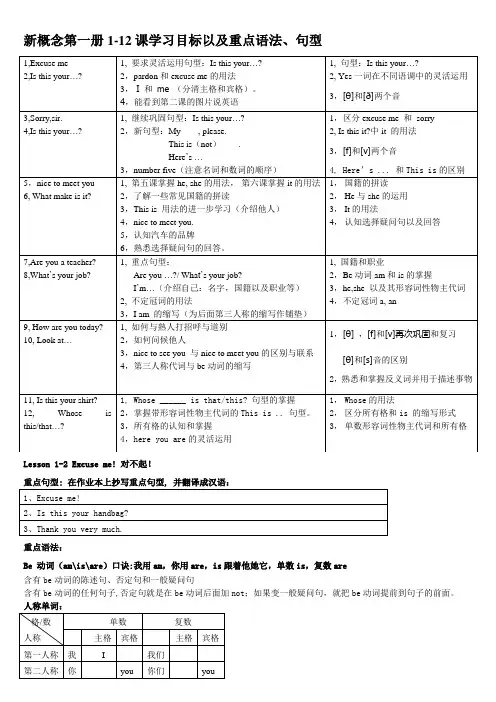
新概念第一册1-12课学习目标以及重点语法、句型Lesson 1-2 Excuse me! 对不起!重点句型: 在作业本上抄写重点句型, 并翻译成汉语:重点语法:Be 动词(am\is\are)口诀:我用am,你用are,is跟着他她它,单数is,复数are含有be动词的陈述句、否定句和一般疑问句含有be动词的任何句子,否定句就是在be动词后面加not;如果变一般疑问句,就把be动词提前到句子的前面。
人称单词:重点句型:重要语法1.祈使句:祈使句:主语通常不直接表示出来,其谓语动词用原型,也叫无主句。
表示命令、请求、建议、叮嘱等。
祈使句真正的主语是你,但省略了。
My umbrella and my coat please. 省略了动词和间接宾语的祈使句。
Keep off the grass! 请勿践踏草地!Help yourself! 请自己动手!某些祈使动词可以后跟and和另一个祈使动词,而不是后跟带to的动词不定式结构。
Come and see this goldfish.Go and buy yourself a new pair of shoes. 去给自己买双新鞋吧。
Wait and see. 等着瞧吧。
2.倒装句:here is 是简单的倒装句,be 动词放在here 的后面,这个句式就可以成为简单的倒装句式。
My ticket is here. 我的票在这。
Here is my ticket. / Here's my ticket.3.状态句之一:某物是某物在英语句子中,有一种句子表述的是静态的内容,只说明状态,没有动作:1).This is my handbag 这是我的手提包2).Is this your umbrella? 这是你的雨伞吗?3).He is my friend .他是我的朋友.Lesson 5 & 6 Nice to meet you. 很高心见到你。
新概念英语第一册Lesson 25之重点语法
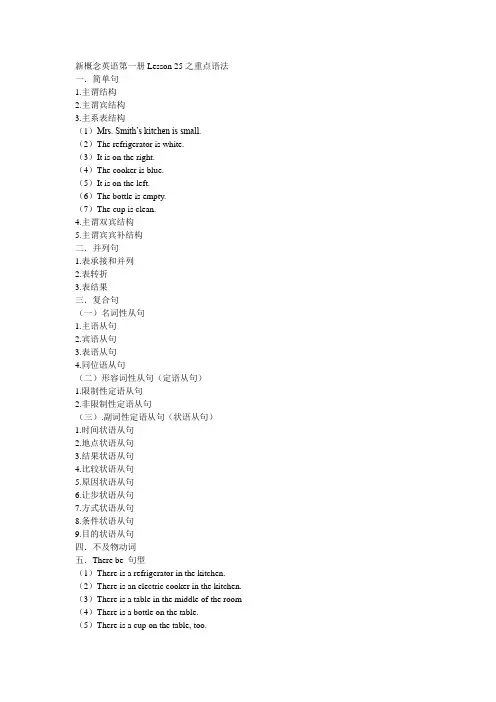
一.简单句1.主谓结构2.主谓宾结构3.主系表结构(1)Mrs. Smith’s kitchen is small.(2)The refrigerator is white.(3)It is on the right.(4)The cooker is blue.(5)It is on the left.(6)The bottle is empty.(7)The cup is clean.4.主谓双宾结构5.主谓宾宾补结构二.并列句1.表承接和并列2.表转折3.表结果三.复合句(一)名词性从句1.主语从句2.宾语从句3.表语从句4.同位语从句(二)形容词性从句(定语从句)1.限制性定语从句2.非限制性定语从句(三).副词性定语从句(状语从句)1.时间状语从句2.地点状语从句3.结果状语从句4.比较状语从句5.原因状语从句6.让步状语从句7.方式状语从句8.条件状语从句9.目的状语从句四.不及物动词五.There be 句型(1)There is a refrigerator in the kitchen. (2)There is an electric cooker in the kitchen. (3)There is a table in the middle of the room (4)There is a bottle on the table.(5)There is a cup on the table, too.一.简单句1.主谓结构2.主谓宾结构3.主系表结构(1)Mrs. Smith’s living room is large.(2)The television is near the window.(3)The armchairs are near the table.(4)The stereo is near the door.(5)The pictures are on the wall.4.主谓双宾结构5.主谓宾宾补结构二.并列句1.表承接和并列2.表转折3.表结果三.复合句(一)名词性从句1.主语从句2.宾语从句3.表语从句4.同位语从句(二)形容词性从句(定语从句)1.限制性定语从句2.非限制性定语从句(三).副词性定语从句(状语从句)1.时间状语从句2.地点状语从句3.结果状语从句4.比较状语从句5.原因状语从句6.让步状语从句7.方式状语从句8.条件状语从句9.目的状语从句四.不及物动词五.There be 句型(1)There is a television in the room.(2)There are some magazines on the television. (3)There is a table in the room.(4)There are some newspapers on the table. (5)There are some armchairs in the room. (6)There is a stereo in the room.(7)There are some pictures in the room.(8)There are some books on the stereo.新概念英语第一册Lesson 29之重点语法一.简单句1.主谓结构2.主谓宾结构3.主系表结构(1)This bedroom is very untidy.4.主谓双宾结构5.主谓宾宾补结构二.并列句1.表承接和并列2.表转折3.表结果三.复合句(一)名词性从句1.主语从句2.宾语从句3.表语从句4.同位语从句(二)形容词性从句(定语从句)1.限制性定语从句2.非限制性定语从句(三).副词性定语从句(状语从句)1.时间状语从句2.地点状语从句3.结果状语从句4.比较状语从句5.原因状语从句6.让步状语从句7.方式状语从句8.条件状语从句9.目的状语从句四.不及物动词五.There be 句型六.英语的语气(一)陈述语气(二)祈使语气(1)Come in, Amy.(2)Shut the door, please.(3)Open the window and air the room. (4)Then put these clothes in the wardrobe. (5)Then make the bed.(6)Then sweep the floor.(7)Dust the dressing table(三)虚拟语气七.疑问句1一般疑问句2特殊疑问句(1)What must I do, Mrs. Jones?3选择疑问句4附加疑问句5陈述疑问句新概念英语第一册Lesson 31之重点语法一.简单句1.主谓结构2.主谓宾结构(1)I beg your pardon?3.主系表结构(1)She’s in the garden, Jane.(2)She’s sitting under the tree.(3)Yes, he is.(4)He’s climbing the t ree.(5)Tim is.(6)The dog’s in the garden, too.(7)It’s running after a cat.(8)It’s running across the grass.4.主谓双宾结构5.主谓宾宾补结构二.并列句1.表承接和并列2.表转折3.表结果三.复合句(一)名词性从句1.主语从句2.宾语从句3.表语从句4.同位语从句(二)形容词性从句(定语从句)1.限制性定语从句2.非限制性定语从句(三).副词性定语从句(状语从句)1.时间状语从句2.地点状语从句3.结果状语从句4.比较状语从句5.原因状语从句6.让步状语从句7.方式状语从句8.条件状语从句9.目的状语从句四.不及物动词五.There be 句型六.英语的语气(一)陈述语气(二)祈使语气(三)虚拟语气七.疑问句1一般疑问句(1)Is Tim in the garden, too?2特殊疑问句(1)Where’s Sally, Jack?(2)What’s she doing?(3)Who’s climbing th e tree(4)What about the dog?3选择疑问句4附加疑问句5陈述疑问句新概念英语第一册Lesson 33之重点语法一.简单句1.主谓结构2.主谓宾结构3.主系表结构(1)It’s a fine day today.(2)Mrs. Jones’s with his family.(3)They are walking over the bridge.(4)Mrs. Jones and his wife are looking at them.(5)Sally is looking at a big ship.(6)The ship is going under the bridge.(7)Tim is looking at an aeroplane.(8)The aeroplane is flying over the river.4.主谓双宾结构5.主谓宾宾补结构二.并列句1.表承接和并列2.表转折(1)There are some clouds in the sky, but the sun is shining.3.表结果三.复合句(一)名词性从句1.主语从句2.宾语从句3.表语从句4.同位语从句(二)形容词性从句(定语从句)1.限制性定语从句2.非限制性定语从句(三).副词性定语从句(状语从句)1.时间状语从句2.地点状语从句3.结果状语从句4.比较状语从句5.原因状语从句6.让步状语从句7.方式状语从句8.条件状语从句9.目的状语从句四.不及物动词五.There be 句型(1)There are some clouds in the sky。
新概念英语第一册第99-100课重点语法
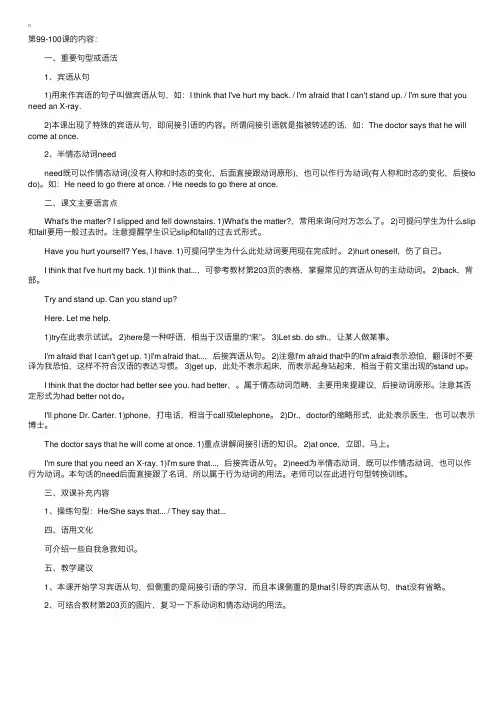
第99-100课的内容: ⼀、重要句型或语法 1、宾语从句 1)⽤来作宾语的句⼦叫做宾语从句,如:I think that I've hurt my back. / I'm afraid that I can't stand up. / I'm sure that you need an X-ray. 2)本课出现了特殊的宾语从句,即间接引语的内容。
所谓间接引语就是指被转述的话,如:The doctor says that he will come at once. 2、半情态动词need need既可以作情态动词(没有⼈称和时态的变化,后⾯直接跟动词原形),也可以作⾏为动词(有⼈称和时态的变化,后接to do)。
如:He need to go there at once. / He needs to go there at once. ⼆、课⽂主要语⾔点 What's the matter? I slipped and fell downstairs. 1)What's the matter?,常⽤来询问对⽅怎么了。
2)可提问学⽣为什么slip 和fall要⽤⼀般过去时。
注意提醒学⽣识记slip和fall的过去式形式。
Have you hurt yourself? Yes, I have. 1)可提问学⽣为什么此处动词要⽤现在完成时。
2)hurt oneself,伤了⾃⼰。
I think that I've hurt my back. 1)I think that...,可参考教材第203页的表格,掌握常见的宾语从句的主动动词。
2)back,背部。
Try and stand up. Can you stand up? Here. Let me help. 1)try在此表⽰试试。
2)here是⼀种呼语,相当于汉语⾥的“来”。
新概念第一册每课知识点整理
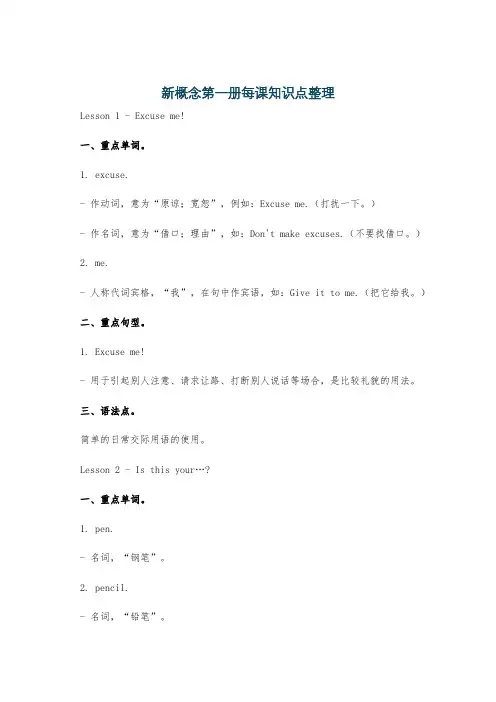
新概念第一册每课知识点整理Lesson 1 - Excuse me!一、重点单词。
1. excuse.- 作动词,意为“原谅;宽恕”,例如:Excuse me.(打扰一下。
)- 作名词,意为“借口;理由”,如:Don't make excuses.(不要找借口。
)2. me.- 人称代词宾格,“我”,在句中作宾语,如:Give it to me.(把它给我。
)二、重点句型。
1. Excuse me!- 用于引起别人注意、请求让路、打断别人说话等场合,是比较礼貌的用法。
三、语法点。
简单的日常交际用语的使用。
Lesson 2 - Is this your…?一、重点单词。
1. pen.- 名词,“钢笔”。
2. pencil.- 名词,“铅笔”。
3. book.- 名词,“书”。
4. watch.- 名词,“手表”;也可作动词,“观看”,如:watch TV(看电视)。
二、重点句型。
1. Is this your pen?- 这是一般疑问句,其结构为“be动词(is/are等)+主语+其他”,回答可以是“Yes, it is.”或者“No, it isn't.”三、语法点。
1. 一般疑问句的构成与回答。
2. 指示代词this的用法,用来指代离说话者较近的人或物。
Lesson 3 - Sorry, sir.一、重点单词。
1. umbrella.- 名词,“雨伞”。
2. please.- 副词,用于请求别人做某事时表示礼貌,如:Please open the window.(请打开窗户。
)二、重点句型。
1. Is this your umbrella?- 同Lesson 2中的一般疑问句结构。
2. Sorry, sir.- “sorry”表示歉意,“sir”是对男性的尊称。
三、语法点。
1. 继续巩固一般疑问句。
2. 尊称“sir”的用法。
Lesson 4 - Is this your…?一、重点单词。
新概念第一册重点句型
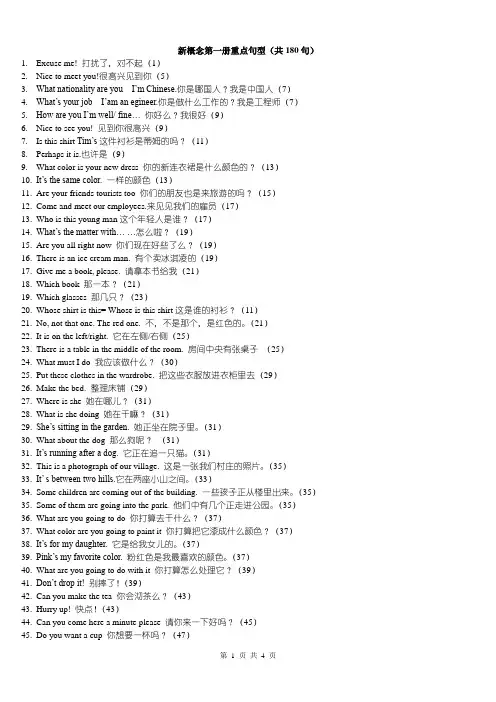
新概念第一册重点句型(共180句)1.Excuse me! 打扰了,对不起(1)2.Nice to meet you!很高兴见到你(5)3.What nationality are you I’m Chinese.你是哪国人?我是中国人(7)4.What’s your job I’am an egineer.你是做什么工作的?我是工程师(7)5.How are you I’m well/ fine…你好么?我很好(9)6.Nice to see you! 见到你很高兴(9)7.Is this shirt Tim’s这件衬衫是蒂姆的吗?(11)8.Perhaps it is.也许是(9)9.What color is your new dress 你的新连衣裙是什么颜色的?(13)10.It’s the same color.一样的颜色(13)11.Are your friends tourists too 你们的朋友也是来旅游的吗?(15)e and meet our employees.来见见我们的雇员(17)13.Who is this young man这个年轻人是谁?(17)14.What’s the matter with……怎么啦?(19)15.Are you all right now 你们现在好些了么?(19)16.There is an ice cream man. 有个卖冰淇凌的(19)17.Give me a book, please. 请拿本书给我(21)18.Which book 那一本?(21)19.Which glasses 那几只?(23)20.Whose shirt is this= Whose is this shirt这是谁的衬衫?(11)21.No, not that one. The red one. 不,不是那个,是红色的。
(21)22.It is on the left/right. 它在左侧/右侧(25)23.There is a table in the middle of the room. 房间中央有张桌子(25)24.What must I do 我应该做什么?(30)25.Put these clothes in the wardrobe. 把这些衣服放进衣柜里去(29)26.Make the bed. 整理床铺(29)27.Where is she 她在哪儿?(31)28.What is she doing 她在干嘛?(31)29.She’s sitting in the garden.她正坐在院子里。
新概念英语一册语法1-72总结
新概念英语第一册1-72课重点语法总结一.时态:一般现在时,现在进行时,一般过去时1. 一般现在时表示一般性,经常性的动作或一般性事实。
◆∙∙∙∙∙∙ 含有be动词的句子I am a student.He is a teacher.The girl is very beautiful.Tim and Jack are students.★变疑问句将be动词移到句首Is he a teacher?Is the girl very beautiful?Are Tim and Jack students?★变否定句在be动词后面加notI am not a student.He is not a teacher.The girl is not very beautiful.Tim and Jack are not students.★肯定回答及否定回答Yes, he is. No, he is not.Yes, she is. No, she is not.Yes, they are. No, they are not.◆∙∙∙∙∙∙ 不含有be动词的句子,而含有一般动词的句子第三人称单数及单数名词作主语He likes books.She likes him.The dog likes bones.★变疑问句在句首加does, 动词变为原型Does he like books?Does she like him?Does the dog like bones?★变否定句在主语及动词之间加doesn’t, 动词变为原型He doesn’t like books.She doesn’t like him.Th e dog doesn’t like bones.★肯定回答及否定回答:Yes, he does. No, he doesn’t.Yes, she does. No, she doesn’tYes, it does. No, it doesn’t.注意:第三人称单数形式一般在动词后面加S,不要和名词复数混淆,变否定句或疑问句时名词复数本身不会有任何变化。
新概念英语第一册单词+短语+重点句型
新概念英语第一册单词+短语+重点句型New Concept English is a popular English language learning series that has been widely used by English learners all over the world. In the first book of the series, students are introduced to basic vocabulary, useful phrases, and key sentence structures. In this document, we will explore some of the important words, phrases, and sentence patterns from New Concept English Book 1.Vocabulary:1. Apple2. Bag3. Cat4. Dog5. ElephantPhrases:1. How are you?2. What's your name?3. Please sit down.4. How do you do?5. What's the time?Key Sentence Patterns:1. Subject + Verb: The cat sleeps.2. Subject + Verb + Object: The dog eats meat.3. Subject + Verb + Adverb: She reads quickly.4. Subject + Verb + Adjective: He is tall.5. Subject + Verb + Object + Adverb: They sing songs loudly.As students progress through New Concept English Book 1, they will become more familiar with these words, phrases, and sentence patterns. By practicing them regularly, students can improve their English language skills and become more confident in using English in everyday conversations.In conclusion, New Concept English Book 1 is a great resource for English learners to build a solid foundation in the language. By mastering the basic vocabulary, useful phrases, and key sentence patterns introduced in this book, students can develop their English proficiency and communicate effectively in English-speaking environments.。
新概念英语第一册第25-26课重点语法
⼀、重要句型或语法
1、there be句型
there is,如:There is a refrigerator in the kitchen.
2、⽅位的表达
介词+the+地点名词,如:on the right, in the middle of the room。
3、冠词的⽤法
定冠词和不定冠词:第⼀次提到⽤不定冠词,再次提到⽤定冠词。
⼆、课⽂主要语⾔点
Mrs. Smith 可以拓展介绍英语名字的含义和来源,如Smith作为普通名词,表⽰“⾦属匠”,如blacksmith表⽰“铁匠”。
refrigerator 注意读⾳和书写。
另外⼀种形式是fridge。
white 可以拓展复习⼀下表颜⾊的单词。
It is on the right. on the right/left,在右边/左边。
强调介词搭配on。
There is an electric cooker in the kitchen. 冠词an的⽤法,因为electric是元⾳开头的。
注意区分cook(厨师)和cooker(炉⼦,炊具)。
in the middle of the room 强调in the middle of的固定搭配。
The bottle is empty. 复习empty作为形容词的意思、⽤法、反义词,然后指出empty作为动词的⽤法,并造句,如:Please empty the bottle.
三、双课补充内容
1、操练句型:There is...
2、复习形容词作表语的⽤法
3、数字:整千数的读法。
新概念英语第一册Lesson125_130重点句型及语法
新概念英语第一册Lesson125~130重点句型及语法【导语】为了方便同学们的学习,小编为您精心整理了“新概念英语第一册Lesson125~130重点句型及语法”,希望有了这些内容的帮助,可以为大家学习新概念英语提供帮助!如果您想要了解更多新概念英语的相关内容,就请关注小编吧!新概念英语第一册Lesson125~126重点句型及语法一、重要句型或语法情态动词本课侧重的是情态动词must和need的用法,同时对比了have to的用法。
其中,需要注意的是must与have to的区别以及must的否定表达。
如:1)Do you have to water it now? I'm afraid I must.问句采用have to,强调的是客观上是否不得不,而回答时采用must,强调是自己主观认为必须。
2)That means you don't need to water the garden.句中的don't need to用作must的否定表达。
二、课文主要语言点Can't you come in and have tea now, Peter?Not yet. I must water the garden first.1)Can't you... 反问句,往往用来提出建议或质疑。
2)not yet,还没有、还没好3)water the garden,给花园浇水。
water在此用作动词,表示浇水的意思,如waterthe flowers,浇花。
Do you have to water it now? I'm afraid I must. 注意have to与must的区别:have to强调是出于客观原因“不得不”做某事,而must则偏重的是主观上认为“必须”。
另外,have to不是情态动词,就是一般的动词短语,之所以会放到情态动词里一起讲解,只是因为它可以表“必须”。
- 1、下载文档前请自行甄别文档内容的完整性,平台不提供额外的编辑、内容补充、找答案等附加服务。
- 2、"仅部分预览"的文档,不可在线预览部分如存在完整性等问题,可反馈申请退款(可完整预览的文档不适用该条件!)。
- 3、如文档侵犯您的权益,请联系客服反馈,我们会尽快为您处理(人工客服工作时间:9:00-18:30)。
第1-24课重点句型
1.Here's your umbrella and your coat.这是您的伞和大衣
2.My coat and my umbrella please.请把我的大衣和伞拿给我。
3.She's Japanese.她是日本人
4.What nationality are you?你是哪国人?
5.I'm Italian.我是意大利人
6.What's your job?你是做什么工作的?
7.I'm a keyboard operator.我是电脑录入员。
8.I'm an engineer.我是工程师。
9.How's Emma?埃玛好吗?
10.She's very well, too.她也很好。
11.Whose shirt is that?那是谁的衬衫?
12.Is this shirt Tim's? 这件衬衫是蒂姆的吗?
13.Tim's shirt's white.蒂姆的衬衫是白色的
14.What colour's your new dress你的新连衣裙是什么颜色的?
15.It's the same colour.一样的颜色
e and meet our employees.来见见我们的雇员。
17.What are their jobs? 她们是做什么工作的?
18.They're keyboard operators她们是电脑录入员。
19.What's the matter, children?怎么啦,孩子们?
20.Give me some glasses please, Jane.请拿给我几只玻璃杯,简
Lesson25-Lesson36
1.There is a refrigerator in the kitchen. 厨房里有个电冰箱。
2.There is a table in the middle of the room.房间的中央有张桌子。
3.The television is near the window. 电视机靠近窗子。
4.There are some magazines on the television.电视机上放着几本杂志。
5.There are some newspapers on the table.桌上放着几份报纸。
6.Shut the door, please.请把门关上。
7.Then put these clothes in the wardrobe.然后把这些衣服放进衣橱里去
8.Who's climbing the tree?谁在爬树?Tim is.蒂姆在爬树。
9.It's running across the grass.它正在草地上跑,
10.It's running after a cat.在追一只猫。
11.They are walking over the bridge 他们正在过桥。
12.There are some boats on the river.河上有几艘船。
13.The ship is going under the bridge.那船正从桥下驶过。
14.The aeroplane is flying over the river. 飞机正从河上飞过。
15.This is a photograph of our village.这是我们村庄的一张照片。
16.It is between two hills.它们于两座小山之间。
17.Here is another photograph of the village. 这是我们村庄的另一张照片。
18.My wife and I are walking along the banks of the river.我和妻子沿河岸走着
19.He is swimming across the river.他正横渡小河。
20.Some children are coming out of the building.一些孩子正从楼里出来。
21.Some of them are going to the park. 他们中有几个正走进公园。
